-
Paper Information
- Previous Paper
- Paper Submission
-
Journal Information
- About This Journal
- Editorial Board
- Current Issue
- Archive
- Author Guidelines
- Contact Us
American Journal of Geographic Information System
p-ISSN: 2163-1131 e-ISSN: 2163-114X
2019; 8(1): 11-25
doi:10.5923/j.ajgis.20190801.02

Key Factors Driving Deforestation in North-Kivu Province, Eastern DR-Congo Using GIS and Remote Sensing
Musumba Teso Philippe1, Kavira Malengera2, Katcho Karume3
1Faculty of Environment Sciences, Université Evangélique en Afrique (UEA), Bukavu, DR, Congo
2Department of Public Health and Family Medecine, Université Evangélique en Afrique (UEA), Bukavu, DR, Congo
3Goma Volcano Observatory, Department of Geochemistry and Environment, Goma, DR, Congo
Correspondence to: Musumba Teso Philippe, Faculty of Environment Sciences, Université Evangélique en Afrique (UEA), Bukavu, DR, Congo.
| Email: |  |
Copyright © 2019 The Author(s). Published by Scientific & Academic Publishing.
This work is licensed under the Creative Commons Attribution International License (CC BY).
http://creativecommons.org/licenses/by/4.0/

Deforestation has become one of major problems in tropical forest regions. Understanding causes of the forest cover loss is an important step to reduce deforestation. This study analyses the relationship between the Forest cover loss and its explaining key factors in North Kivu province, eastern Democratic Republic of Congo (DRC). Geospatial methods were used in this study to estimate the loss of the forest cover change in North Kivu using Landsat 7 ETM+ and Landsat 8 OLI/TIRS images for the period from 2001 to 2015. The regression analysis was performed using the Ordinary Least Square Regression (OLS) to analyze the spatial stationary factors of deforestation and the Geographically Weighted Regression (GWR) in ArcGIS 10.3 software for the non-stationary factors. The findings reveal an annual rate of deforestation of 1.7% meaning that an average of 70,000 ha of forest area is lost each year. The GWR model was found as the best predictor that explains the Forest cover loss at 93% with the Agriculture Expansion (AE), Slope (SL), Distance from road (DR) and Population Density (PD) as key factors to explain the Forest cover loss. Measures of reducing deforestation in Nord-Kivu should be based on these four key factors for more effectiveness.
Keywords: Modelling, Forest Cover loss, Geographic Information System (GIS), Remote Sensing, Deforestation, North-Kivu
Cite this paper: Musumba Teso Philippe, Kavira Malengera, Katcho Karume, Key Factors Driving Deforestation in North-Kivu Province, Eastern DR-Congo Using GIS and Remote Sensing, American Journal of Geographic Information System, Vol. 8 No. 1, 2019, pp. 11-25. doi: 10.5923/j.ajgis.20190801.02.
Article Outline
1. Introduction
- The tropical forest is very important for the life of human being on the earth. It provides ecological services at the global scale [1] and plays an important role in the global carbon cycle [2, 3]. On a local scale, forests regulate water cycles and provide vegetative cover that protects the soil from erosion [4]. In the last several decades, the disturbance and loss of tropical forest have been observed in many developing countries. Forest cover has been converted to cropland, pasture and other man-made cover types in response to the humans’ demand of food, energy and other economic interests [5, 6]. This phenomenon has induced biodiversity loss, erosion and floods [7].The North Kivu province in the Eastern part of DRC is not an exception of the deforestation phenomenon taking place in the tropical region. The DRC Ministry in charge of Environment and Nature Conservation and Tourism reported the hotspot of loss of forest cover in some regions around popular cities namely Kinshasa, Lubumbashi, Kananga, Kisangani and Kindu, as well as in the Albertin Rift (Figure 1): Province Orientale, South-Kivu and North-Kivu [8]. Except Kinshasa, the province of North Kivu had the highest annual population growth rate in DRC [9] and this number increased by more than 15% between 2010 and 2015 [10]. Hence, population increases pressure on the available forest in the region for their livelihood.
 | Figure 1. Albertin Rift Region |
2. Study Area
2.1. Location of the Study Area
- The study area the North-Kivu province located in the Eastern part of the DRC. North-Kivu is one of the provinces of DRC that extends on both sides of the Equator at latitude 0° 58’ - -2° 3’ and Eastern longitude 27° 14’ - 29° 58’ (Figure 2).
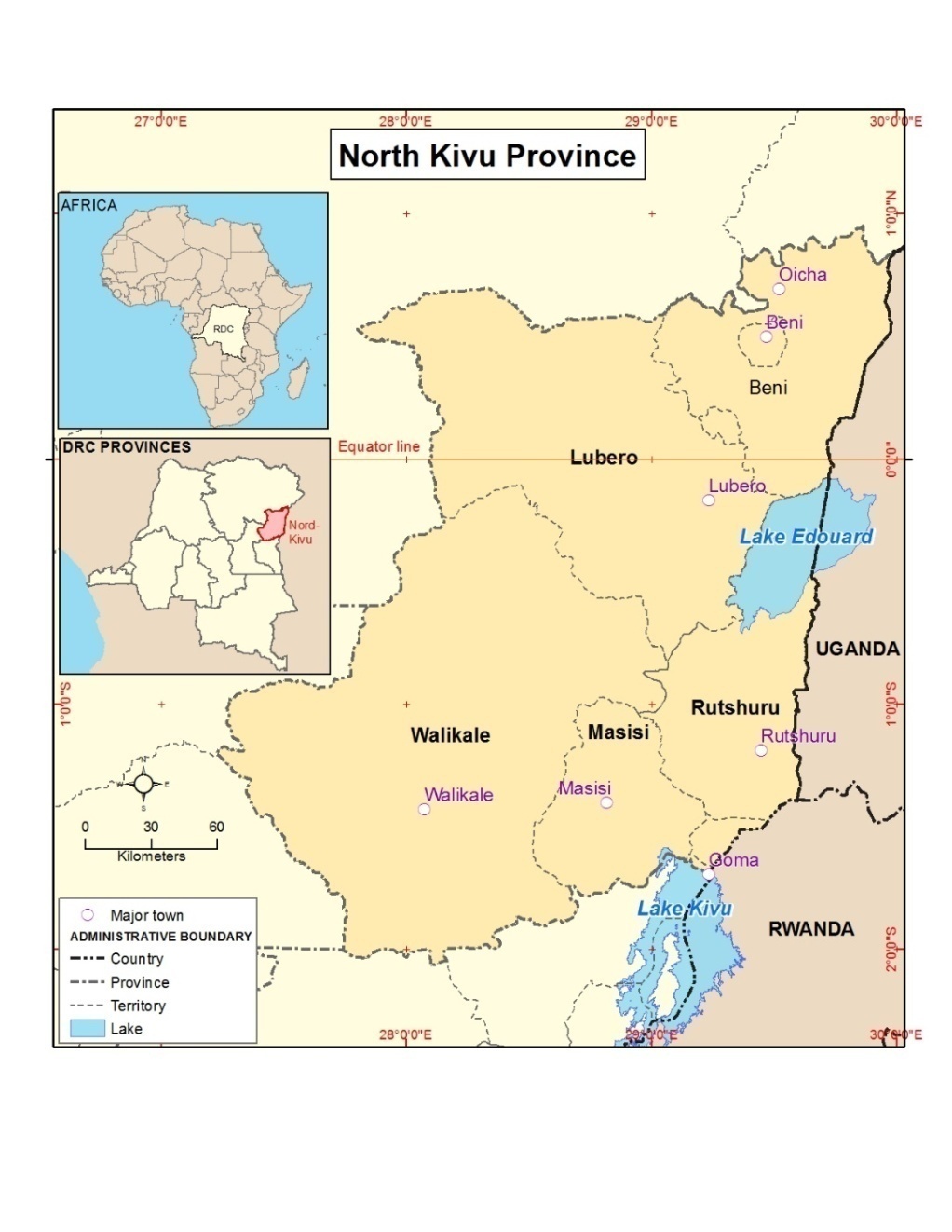 | Figure 2. Location map of the Nord-Kivu province |
2.2. Relief and Climate of North-Kivu
- The North-Kivu topography varies between 800 and 2,500 meters of altitude. However, mountains reach up to 2,500 such as mount Ruwenzori (5,119 m), volcanoes Nyamulagira volcano (3,056 m) and Nyiragongo volcano (3,470 m) [22]. The physiology of North Kivu is the result of the cracking in the Albertin Rift valley that created low and up lands from Lake Albert in North-East DRC to Lake Malawi [23].The diversity of climate in North Kivu is a result of the heterogeneity of the topography. Below 1,000 meters the average temperature is 23°C, around 1,500 meters the temperature is near 19°C and around 2,000 m the temperature is near 15°C. The average annual rainfall varies between 1,000 mm and 2,000 mm. The lowest monthly precipitation is recorded between January and February and July and August. The North Kivu climate is characterized by four seasons: two wet seasons and two dry seasons. The first wet season appears between mid-August and mid-January and the second in mid-February to mid-July. However, the two dry seasons appear in a very short time. The first is observed between mid-January and mid-February and the second between mid-July and mid-August [22].
3. Materials and Methods
3.1. Variables
- The area covered by forest in 2001 and converted into non-forest cover area in 2015 was the dependent variable used to analyze the key factors explaining the Forest Cover Loss (FL) in the province of North Kivu, DRC. According to the United Nations Food Agriculture Organization (FAO), the forest is considered as a land spanning 0.5 hectare with trees higher than 5 meters and a canopy cover more than 10 percent [24]. The Forest loss includes not only the loss of the natural forest area but also the afforested and reforested area. The potential explaining factors we analyzed are described in the Table 1. Direct factors, in case of developing countries, are the replacement of the forest area to a non-forest land due to human activities (e.g. conversion of forest area into agriculture) or to natural hazards like volcano eruption. However, the indirect drivers relate to complex interactions of social, economic, technologic, cultural and political processes that affect direct drivers to cause deforestation [25, 26].
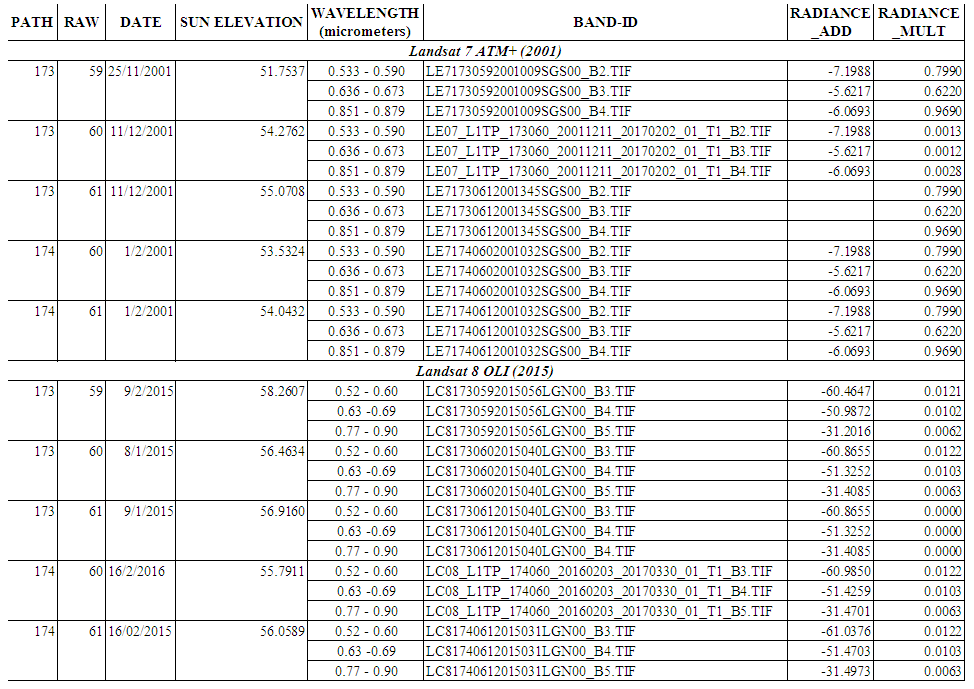 | Table 1. Band specifications and scalar information of used Landsat images |
3.2. Data Used
- This study was carried out using LANDSAT 7 ETM+ for 2001 and LANDSAT 8 OLI/TIRS for 2015 temporal images downloaded from http://earthexplorer.usgs.gov (Figure 3).
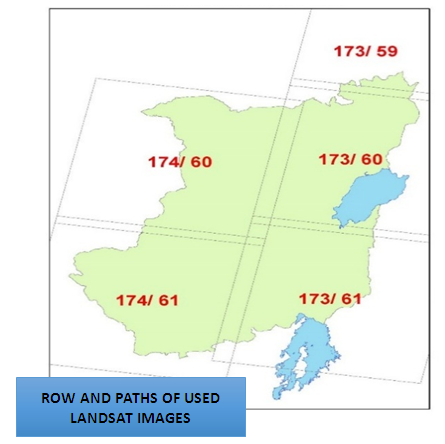 | Figure 3. Raw and path of Landsat images covering the Nord-Kivu province |
3.3. Landsat Processing
- The forest cover, the agriculture, the urban and the lava cover areas were derived from LANDSAT 8 OLI/TIRS and LANDSAT 7 ETM+, using the supervised multispectral classification. All used satellite images of 30 m of spatial resolution were captured during the wet season for comparison (Figure 4). The main scalar information and band specifications of used images are found in Table 1.
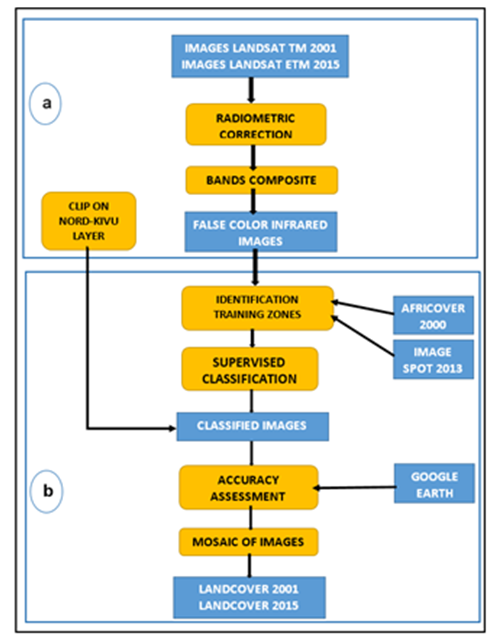 | Figure 4. Landsat Processing Methodology |
 | (1) |
 | (2) |
 | (3) |
 | (4) |
3.4. Cartographic Modelling of the Variables
- The cartographic modelling of the variables from the table 2 as summarized in the Figure 5 was processed. This operation facilitated the measurement of these variables before their integration in one fishnet layer for statistic tests. A shape file of fishnet with rectangular grids of 3 km x 3km for the study area was first created. This has resulted to a total of 6812 patterns. The Raster Calculator and other tools of ArcGIS 10.3 were used in the process to produce thematic maps for the dependent and explaining variables. Figure 5 presents the workflow followed to create thematic maps of all variables used for this study.
 | Table 2. Dependent and independent variables |
 | Figure 5. Extraction and modeling schema of dependent and explaining variables |
3.5. Statistical Analysis
3.5.1. Ordinary Least Square and Geographically Weighted Regression
- Three tools were used to assess the relationship between the forest cover loss and the candidate variables. The Explanatory Regression tool was used for the model selection by generating a list of models with AICc coefficients which indicated the best model that was tested by OLS tool to detect the driving factors explaining the deforestation in the study area. The OLS regression and GWR were used to identify the key factors of deforestation and analyze their spatial heterogeneity. Subsequently, the GWR tool was also used to assess a limited key factor that can be used to predict the forest cover loss in space and time throughout the study area [29, 30].
3.5.2. Calculation of Measures for Goodness-Of-Fit
- Measures of goodness-of-fit for this study aims at quantifying how well used models (Exploratory regression, OLS and GWR) fits the data and identifying the best model. A total of six main statistic tests were calculated using ArcGIS 10.3 software and interpreted. These measures include Adjusted R-Squared, Variable Inflation Factor (VIF), Jarque-Bera (JB) statistic, Moran’s Index (Moran’s I) Spatial autocorrelation, KOENKER Breusch-Pagan (BP) statistic and AIKAKE’s Information Criterion (AIC). These statistics tests helped to specify a model which meets some key requirement, i.e. the model cannot miss key explanatory variables; residuals must be normally distributed and free from spatial autocorrelation [31] to determine the passing model among two or more.The coefficient of determination R2 value, which determines how well independent variables are explaining the dependent variable, is a measure that helps to judge the performance of the model. However, a good choice for OLS and GWR models is rather based on a high Adjusted R2 which is a calibration of R2 value. The adjusted R2 value generally increases when more independent variables are added to the model [32]. The Adjusted R2 is calculated using the Equation 5 referring to the general Equation 6 for R-Squared with RSS = residual sum-of-squares, TSS = total sum-of-squares, y = response values,
 = fitted values,
= fitted values,  = the mean of measure values, n = sample and p = number of parameters [33].
= the mean of measure values, n = sample and p = number of parameters [33]. | (5) |
 | (6) |
 | (7) |
 and
and  are the estimated of the third and fourth moments respectively,
are the estimated of the third and fourth moments respectively,  is the sample mean, and
is the sample mean, and  is the variance. Parameters used to estimate
is the variance. Parameters used to estimate  and
and  are found in the same equations.
are found in the same equations. | (8) |
 | (9) |
 | (10) |
 is the mean of the X variable, Wij are elements of the weight matrix and S0 the sum of the elements of the weight matrix [37].
is the mean of the X variable, Wij are elements of the weight matrix and S0 the sum of the elements of the weight matrix [37]. | (11) |
 is the estimate of standard deviation of the residuals, and (S) is the trace of the hat matrix.
is the estimate of standard deviation of the residuals, and (S) is the trace of the hat matrix.  | (12) |
 | (13) |
3.5.3. Criteria Used for Model Selection
- Based on the calculation in section 3.5.2, five criteria were considered, as suggested by Jichuan Sheng et al. [3] to assess the best models: 1) The Adjusted R-squared should be equal to or greater than 0.5 (Adjusted R2 _ 0.5), which denotes that the model's goodness of fit should not be less than 0.5;2) The p-value for regression coefficients should be no more than 0.05 (p-value _ 0.05), which suggests that the variable is statistically significant to the model;3) The variance inflation factor value of regression variables should be no more than 7.5 (VIF _ 7.5), which ensures that there is not multicollinearity and redundant independent variables in the regression model;4) The p-value for Jarque-Bera statistic should be greater than 0.1, which can ensure that the residuals of regression model are normally distributed. If the p-value for the Jarque-Bera statistic (test) is statistically significant, the regression model is biased and the model predictions cannot be fully trusted. When the model is biased, a key explanatory variable may be missed;5) The p-value for spatial autocorrelation should be more than 0.1, which ensures that there is no spatial autocorrelation in the regression model based on the Moran's I value. A significant Moran's I value indicates that there is spatial autocorrelation in the model; a positive Moran's I value suggests a clustering trend, and a negative value suggests the existence of a discrete trend.
4. Results
4.1. Land Cover Change and Thematic Maps of Variables
- After the supervised classification of the Landsat images of the two periods (2001 and 2015), the change detection method was applied to estimate the forest cover loss, the agriculture area expansion, the urban area expansion and volcanic lava area expansion as indicated on the land cover maps (Figure 6). The overall classification accuracy was 87% following the Ground Control Points collected from Google Earth Professional application. During the 2001 to 2015 period, the annual rate of deforestation was estimated to 1.7% using Equation 3. Moreover, we estimated to 700 square kilometers, the forest cover disappearing every year in North Kivu province (Equation 4). In some areas of the southern and northern parts of Lake Edward within the Virunga National Park, urban area has decreased in 2015 in reference to 2001 (Figure 6). This phenomenon may be explained by large evacuation operations of human population from the park initiated by the National Institute of Nature Conservation (ICCN) during 2003 and 2013 period. These operations were supported by ICCN partners and followed by some good governance measures of protected areas such as demarcation of the Virunga National Park on some parts of its border (39, 40).
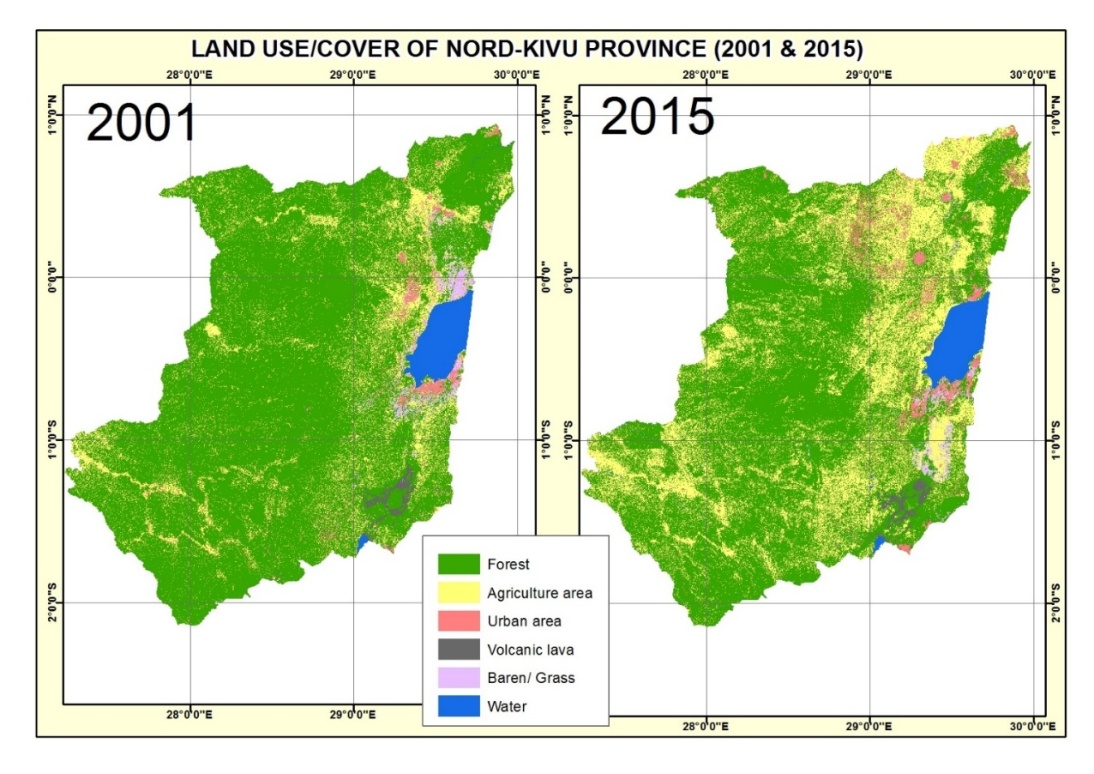 | Figure 6. Land cover maps of Nord-Kivu for 2001 and 2015 |
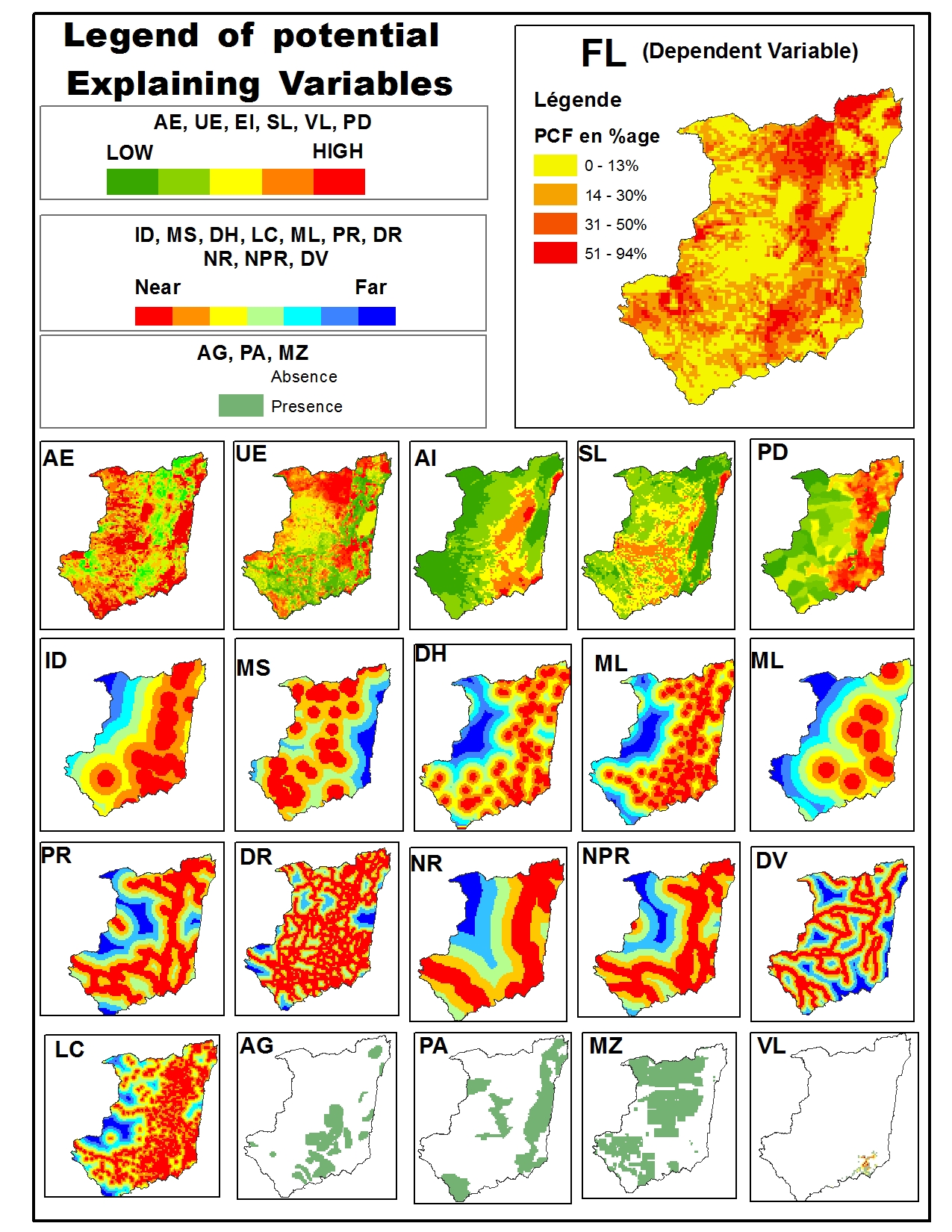 | Figure 7. Thematic maps of variables |
4.2. Explanatory Regression Model Result
- We used the exploratory regression of ArcGIS 10.3 software and came up with 17 regression models shown in the Table 3. Based on the criteria listed in the section 3.5.3, the 15th model with the lowest AICc of 106,053 was the best fit. All these 17 models have the Adjusted R square value greater than 0.5 and a p-value for regression coefficients less than 0.05 that shows the fitness to the criteria in section 3.4.3. For all these 17 models, Jarque-Bera, Koenker (BP) and spatial autocorrelation of residuals returned a p-value of 0.000. This result was not included in Table 3 for conciseness.
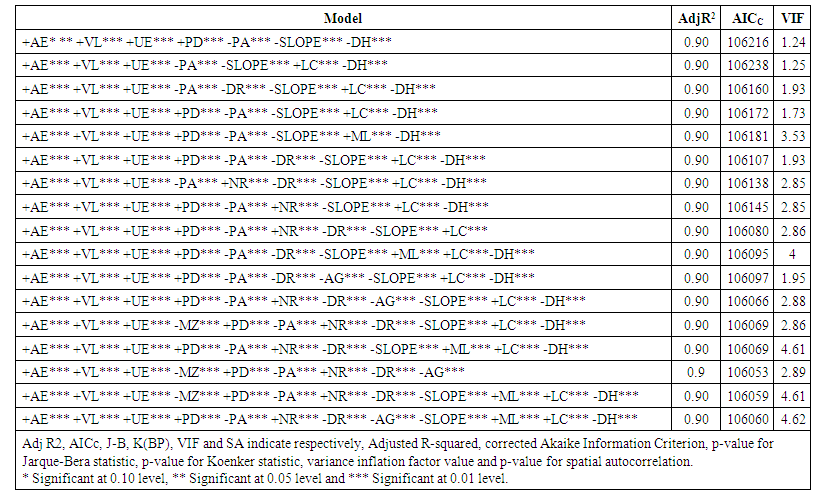 | Table 3. Summary of the Explanatory Regression model |
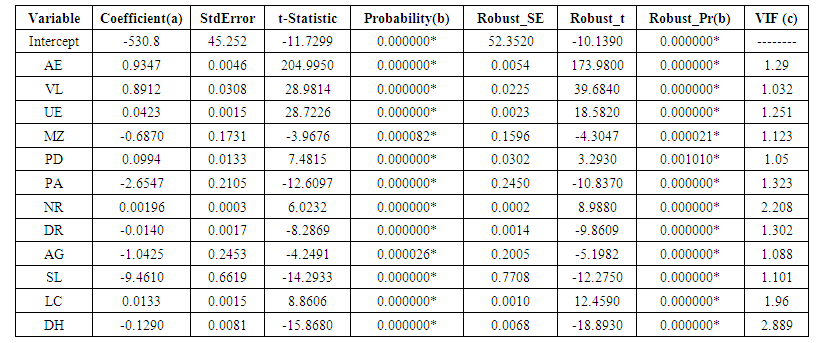 | Table 4. Summary of Explanatory Regression output |
4.3. OLS Output Result
- The global OLS linear model output of the 12 explaining variables is shown in the Table 4. After the test, the coefficients of Euclidean distance from Mining Sites (MS) and from National Road (NR) did not indicate the expected signs. This means that these unexpected coefficient signs indicate problems in the OLS model [41]. Consequently, OLS was launched for the second time without these variables and the results of the output are presented in the Table 5 including only 10 independent variables.
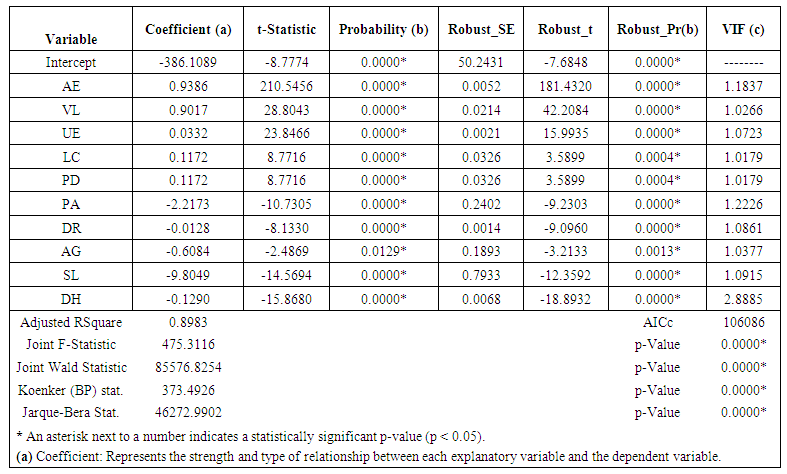 | Table 5. Summary of the OLS output |
4.4. GWR Output Result
- The result of our analysis with OLS in Table 5 confirmed that the relationship between forest cover loss and its explaining variables varies over space. So, the output of the GWR analysis examining the heterogeneous association between the variables is shown in the Table 6.
 | Table 6. Summary of GWR output |
5. Discussion
- Among the twenty potential explaining variables tested in Table 4, ten passed with OLS regression model (Table 5) and only four passed with the GWR model (Table 6). According to the OLS regression results, there was a positive association between Forest cover loss (FL) and Agriculture expansion (AE), Volcanic lava expansion (VL), urban area expansion (UE) and the Euclidean distance from localities (LC). Our results corroborate those of Ghislain R. et al. [21] who found that Agriculture and urban expansion were the key parameters impacting forest cover loss in Panama corridor. Some other studies also revealed a positive association between the forest and the distance from roads and the density of population such as Vincent Bax et al. [20] in Amazonian Peruvian. The actor’s based survey conducted by the Ministry of Environment, Nature Conservation and Tourism (MECNT) of DRC also cited the agriculture among the key driving factors of deforestation in North Kivu [42].The same OLS regression model results indicated a negative association with the Presence of Protected Area (PA), the Euclidean distance from roads (DR), the presence of armed groups (AG), the Slope (SL) and the Euclidean distance from hospitals (DH). The findings of Christopher P. B. et al. [19] and Van B. et al. [42] also revealed a positive association between the deforestation and the presence of protected area in Amazonian forest and DRC respectively. Conflict may decrease or increase deforestation depending on the relationship between conflict and other causes of land use change [43]. In the North Kivu province, the population does not have access to agriculture lands in the regions influenced by local or foreign armed groups. Consequently, the forest cover in the areas influenced by armed groups had less pressure from population than secured area.However, the Koenker (BP) statistic indicated that the OLS was not a good predictor of the forest cover loss in the North-Kivu province. This was because the independent variables vary over space. Hence, the GWR was considered as the model, which can predict better the deforestation parameters in North Kivu province as this consider the variation of the explaining factors over the geographic space.In general, there was a positive correlation between the forest cover loss and the Agriculture expansion (AE) and the Population density (PD), and a negative correlation with the Distance from roads (DR) and the Slope (SL). This situation is due to the increase of population of North Kivu province last decades. As twenty six percent of North Kivu population rely on agriculture [44], so they need accessing to agriculture lands not far from roads and in flat areas.Furthermore, the Figure 8 (AE) indicates that the coefficients of the Geographically Weighted Regression model for the Agriculture expansion had different values over the North Kivu province. The deeper color (blue) suggests the strong associations between the Forest cover loss and the agriculture expansion, while the lighter color (yellow) shows the week correlations. The Figure 8 (DR, PD, SL) shows the same reality for the parameters Distance from roads, Population Density and Slope.
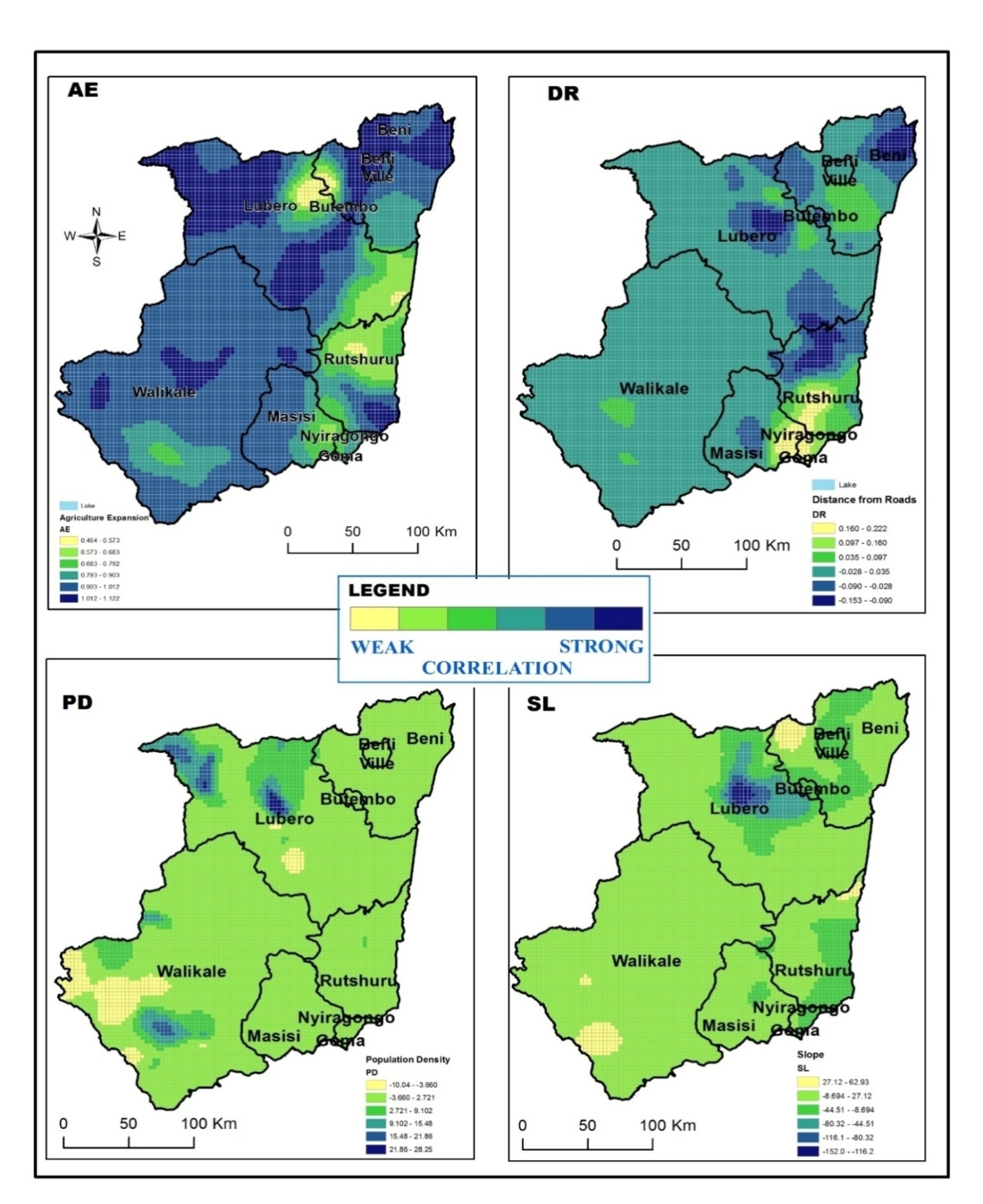 | Figure 8. Spatial distribution of Key factors explaining deforestation |
6. Conclusions
- This study assessed the forest cover loss in the North Kivu province, Eastern part of DRC and analyzed its key explaining factors. The study was carried-out for the 2001 to 2015 period. A set of twenty potential independent variables were modelled and analyzed via a geospatial approach to identify the key explaining factors from them.Using ArcGIS 10.3 software tools, results revealed an annual deforestation rate of 1.7% in the North Kivu province that equal to 700 hectares of forest cover loss every year. Both OLS and GWR regression models were tested and the GWR was estimated as the best predictive model for the Forest cover loss in the study area. The Koenker (BP) Statistic of OLS had a statistically significant p-Value (0.000*) indicating that the regression model was not stationary. Hence, there was a variation of the explaining variables in the geographic space, thus the OLS was not a good model to explain the Forest cover loss. The GWR model has the smallest AICc (103054.83) than OLS (106086.8456) and, the highest Adjusted R-square (0.9364) than the OLS (0.8984).Using the GWR model, we identified four key factors that explained the forest cover loss in the study area. We found a positive correlation between the forest cover loss and Agriculture expansion (AE) and the Population density (PD), and a negative correlation between the Forest cover loss and the Euclidean Distance from roads and the Slope (SL). In the last decades, the population of North Kivu province has increased while most of them rely on the agriculture for their livelihood. Accordingly, more forest cover was converted to agriculture area, especially in the regions near the roads as well as in less steep areas. Based on our findings, we recommend the promotion of the sedentary farming in North Kivu and the prohibition of the stubble-burning and shifting agriculture. Moreover, the steep areas should be taken as priority during the afforestation and reforestation activities.
AKNOWLEDGEMENTS
- Autors are thankful to the Evangelical University of Africa (UEA-Bukavu), for access to the virtual library. Special thanks to all who accepted to read this paper and provided valuable suggestions.
 Abstract
Abstract Reference
Reference Full-Text PDF
Full-Text PDF Full-text HTML
Full-text HTML